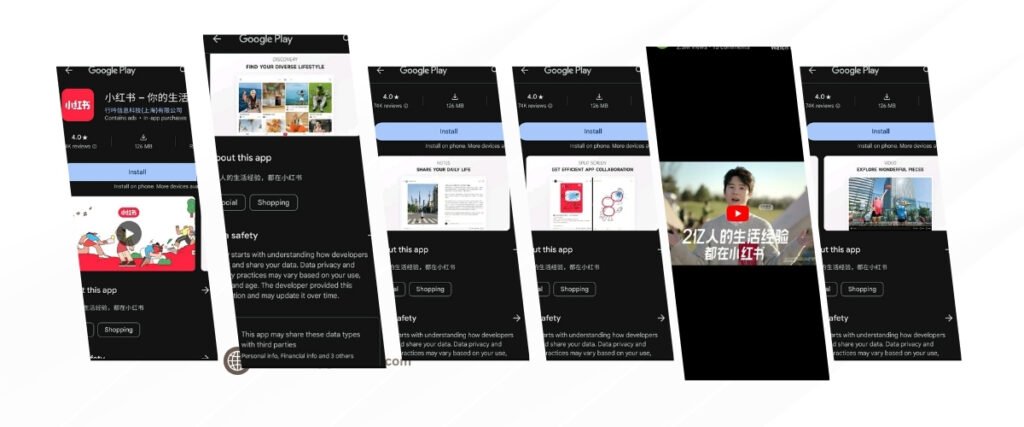Table of Contents
Toggle- When was Xiaohongshu founded?
- Who are the founders of Xiaohongshu?
- What is Xiaohongshu known for?
- How many registered users does Xiaohongshu have as of 2020?
- What percentage of Xiaohongshu users are born after 1990?
- What is the primary demographic group that Xiaohongshu attracts?
- What is the percentage of female users on Xiaohongshu?
- What type of content is predominantly shared on Xiaohongshu?
- What is RED Mall on Xiaohongshu?
- Where are Xiaohongshu’s headquarters located?
- When did Xiaohongshu transition into a cross-border e-commerce platform?
- In what year did Xiaohongshu set up its warehouses in Shenzhen and Zhengzhou?
- How much funding did Xiaohongshu secure in June 2018?
- What is REDelivery in Xiaohongshu?
- Why did Xiaohongshu adjust its corporate strategy in 2018?
- What regulatory setback did Xiaohongshu face in late 2018?
- What is one of the recent controversies Xiaohongshu faced in October 2021?
- What did Xiaohongshu do to combat fraudulent content in December 2021?
- How many brands and merchants did Xiaohongshu take action against in December 2021?
- How much damages did Xiaohongshu seek in its lawsuit against ghostwriting brokers in January 2022?
- What was the fine Xiaohongshu received in January 2022 for failing to remove harmful content involving minors?
- Which government banned public sector employees from using Xiaohongshu in December 2022?
- What was the reason behind Xiaohongshu’s decision to transfer its IPO from the United States to Hong Kong in October 2021?
- How much did Sequoia China acquire Xiaohongshu shares for in 2023?
- What is the primary focus of content shared by users on Xiaohongshu?
- How does Xiaohongshu facilitate social discovery for its users?
- Which major Chinese cities have Xiaohongshu warehouses?
- What is the main function of RED Mall on Xiaohongshu?
- How many daily active users did Xiaohongshu have in 2021?
- In what year did Xiaohongshu surpass 50 million users?
- How did Xiaohongshu evolve from its founding in 2013 to becoming a cross-border e-commerce platform?
- What significance did the introduction of REDelivery hold for Xiaohongshu’s international operations?
- Who were the major investors in Xiaohongshu during its rapid growth phase?
- How did Xiaohongshu respond to regulatory setbacks in late 2018?
- What changes did Xiaohongshu make in its corporate strategy to adapt to evolving user demographics?
- What were the primary reasons behind Xiaohongshu’s decision to transfer its IPO to Hong Kong in October 2021?
- How did Xiaohongshu address concerns regarding content authenticity in October 2021?
- What measures did Xiaohongshu take to combat fraudulent content in December 2021?
- What was the outcome of Xiaohongshu’s legal action against ghostwriting brokers in January 2022?
- How did Xiaohongshu respond to regulatory penalties and cybersecurity concerns in January 2022?
- What impact did Taiwan’s government ban have on Xiaohongshu in December 2022?
- How did Xiaohongshu attract significant investment despite facing regulatory challenges?
- What role did Sequoia China play in Xiaohongshu’s investment landscape?
- How does Xiaohongshu differentiate itself from other social commerce platforms in China?
- What features contribute to Xiaohongshu’s appeal among its user base?
- What role do influencers play in shaping content on Xiaohongshu?
- How does Xiaohongshu foster community engagement among its users?
- What strategies has Xiaohongshu employed to maintain its growth trajectory?
- What role does user-generated content play in Xiaohongshu’s ecosystem?
- How does Xiaohongshu monetize its platform?
- What opportunities and challenges does Xiaohongshu face in international markets?
- How does Xiaohongshu handle cross-border transactions?
- What measures does Xiaohongshu take to ensure the authenticity of product reviews?
- How does Xiaohongshu leverage data analytics to enhance user experience?
- What initiatives has Xiaohongshu undertaken to address concerns regarding data privacy and security?
- How does Xiaohongshu integrate social media and e-commerce functionalities?
- What partnerships has Xiaohongshu formed with international brands and retailers?
- How does Xiaohongshu tailor its content to appeal to different demographic groups?
- What role does artificial intelligence play in Xiaohongshu’s platform?
- How does Xiaohongshu stay updated with the latest consumer trends?
- What strategies does Xiaohongshu employ for user acquisition and retention?
- How does Xiaohongshu balance user-generated content with sponsored content?
- What are some key metrics Xiaohongshu uses to measure its success?
- How does Xiaohongshu engage with its user community to gather feedback and suggestions?
- What measures has Xiaohongshu implemented to ensure a positive user experience?
- How does Xiaohongshu handle customer complaints and inquiries?
- What steps does Xiaohongshu take to prevent fraudulent activities on its platform?
- How does Xiaohongshu comply with regulatory requirements in different markets?
- What role do customer reviews play in influencing purchasing decisions on Xiaohongshu?
- How does Xiaohongshu adapt to changing market dynamics and consumer preferences?

Introduction To Xiaohongshu:
Originating from China in 2013, Xiaohongshu has swiftly become a prominent player in the realm of social commerce and lifestyle content, accumulating a substantial user base of 200 million individuals. Renowned for its unique blend of product discovery, user-generated recommendations, and engaging content, Xiaohongshu has redefined the e-commerce landscape in China. The platform’s success in amassing 200 million users speaks to its influence in shaping consumer trends and preferences, making it a go-to destination for users seeking personalized recommendations and a vibrant community centered around lifestyle and shopping.
Overview of Xiaohongshu:
Xiaohongshu, or “Little Red Book,” is a prominent social media and e-commerce platform in China, often likened to Instagram for its combination of social sharing and shopping features.
User Demographics and Usage:
As of 2020, Xiaohongshu boasted over 450 million registered users, with more than 121 million monthly active users. The platform primarily attracts younger demographics, with 70% of users born after 1990, and nearly 70% of them being female.
Content and Features:
Xiaohongshu serves as a hub for users and influencers to post, discover, and share product reviews, particularly focusing on beauty and health products. Additionally, travel bloggers contribute content related to tourism and leisure destinations. The platform hosts the RED Mall, catering to Chinese users by selling international products.
Community Engagement:
Users on Xiaohongshu engage through various mediums such as vlogs, shopping experiences, and creative content including photos, text, videos, and live streaming.
Blogging and Social Features:
Xiaohongshu allows users to become bloggers covering a wide array of topics including beauty, fashion, food, travel, entertainment, fitness, and parenting. The platform facilitates social discovery of new brands, products, and ideas. It integrates an in-app shopping interface for seamless product browsing, searching, and purchasing.
Growth and Headquarters:
Xiaohongshu’s headquarters are situated in Huangpu District, Shanghai. The platform experienced significant growth in 2021, with daily active users (DAU) surging from 20 million to 40 million, while monthly active users (MAU) doubled to exceed 150 million during the same period.
History:
Founding and Early Development (2013-2015)
Xiaohongshu Emergence and Cross-Border Focus Xiaohongshu was established in 2013 by Miranda Qu and Charlwin Mao initially serving as an online tour guide for Chinese shoppers. It evolved into a platform where users could review products and share shopping experiences. By October 2014, it transitioned to a cross-border e-commerce platform, facilitating direct purchases of overseas products by Chinese consumers.
Expansion and Logistics Development In 2015, Xiaohongshu expanded its operations by setting up warehouses in Shenzhen and Zhengzhou, enhancing its logistical capabilities to better serve its growing user base.
Rapid Growth and Investment (2016-2018)
Community Growth and Sales Milestones By May 2017, Xiaohongshu had amassed over 50 million users and achieved significant sales volume, nearing CN¥10 billion, solidifying its position as a major community e-commerce platform. During this period, Xiaohongshu introduced its international logistics system, REDelivery, further streamlining cross-border transactions.
Strategic Investment and Internationalization In June 2018, Xiaohongshu secured a substantial US$300 million funding round led by Alibaba and Tencent, propelling its valuation to US$3 billion. This marked a significant milestone in its internationalization efforts, attracting a diverse user base beyond China’s borders.
Regulatory Challenges and Strategic Adaptation (2018-2021)
Regulatory Setbacks and User Demographics Despite its rapid expansion, Xiaohongshu faced regulatory hurdles toward the end of 2018, leading to the suspension of its app store presence. Initially catering predominantly to female users, the platform sought to diversify its user base, particularly attracting male users.
Corporate Strategy Shift and Advertising Initiatives To address its evolving user demographics, Xiaohongshu adjusted its corporate strategy to appeal to a broader audience, actively promoting male user-generated content. Advertising efforts targeted male-centric online spaces, signaling a shift in its marketing approach.
Recent Developments and Challenges (2021-2023)
IPO Transfer and Regulatory Compliance In October 2021, Xiaohongshu decided to transfer its IPO from the United States to Hong Kong, partly due to regulatory requirements, including cybersecurity reviews for companies holding significant user data. This decision was influenced by the suspension of its US listing.
Government Bans and Investment In December 2022, Taiwan’s government banned public sector employees from using Xiaohongshu over national security concerns. Despite regulatory challenges, Xiaohongshu attracted significant investment interest, with Sequoia China acquiring shares at a valuation of $14 billion in multiple transactions in 2023.
Timeline | Action |
Founding and Early Development | |
(2013-2015) | |
Xiaohongshu Emergence and Cross-Border Focus: Established in 2013 as a tour guide, transitioned to a cross-border e-commerce platform by October 2014. | |
Expansion and Logistics Development: Set up warehouses in Shenzhen and Zhengzhou in 2015. | |
Rapid Growth and Investment | |
(2016-2018) | |
Community Growth and Sales Milestones: Surpassed 50 million users by May 2017, with significant sales. Introduced REDelivery for international logistics. | |
Strategic Investment and Internationalization: Secured US$300 million funding in June 2018, expanding globally and attracting diverse users. | |
Regulatory Challenges and Strategic | |
Adaptation (2018-2021) | |
Regulatory Setbacks and User Demographics: Faced regulatory hurdles in late 2018, sought to diversify user base. | |
Corporate Strategy Shift and Advertising Initiatives: Adjusted strategy to attract male users and shifted advertising focus accordingly. | |
Recent Developments and Challenges | |
(2021-2023) | |
IPO Transfer and Regulatory Compliance: Moved IPO to Hong Kong in October 2021, responding to regulatory requirements. | |
Government Bans and Investment: Taiwan banned public sector use in December 2022, while attracting significant investment in 2023. |
Controversies:
Content Authenticity Concerns (October 2021)
Xiaohongshu’s Acknowledgment and Response In October 2021, Xiaohongshu faced criticism for the prevalence of heavily filtered and stylized photographs on its platform. This led to an acknowledgment by Xiaohongshu, via a statement on WeChat, regarding the issue of travel influencers posting overly beautified photos of scenic spots. The platform issued an apology, recognizing that users were misled as these images were not clearly labeled as creative photography, leading to discrepancies between expectations and reality.
Combatting Fraudulent Content (December 2021)
Formation of Anti-Fraud Team and Implementation of Systems In response to the erosion of public trust, Xiaohongshu established a dedicated team in December 2021 to identify and remove fraudulent content. They implemented a system combining algorithms and human checks to detect and block falsified content. Subsequently, Xiaohongshu took action against 81 brands and merchants, deleting 172,600 fake reviews, and disabling 53,600 accounts, according to official statements.
Legal Action Against Fraudulent Practices (January 2022)
Lawsuit Against Ghostwriting Brokers In January 2022, Xiaohongshu filed a lawsuit against four companies operating ghostwriting broker sites, aiming to restore consumer trust. These companies were accused of facilitating fraudulent practices like producing fake reviews and click farming. Xiaohongshu sought US$1.57 million in damages for reputational harm and infringement of consumer rights caused by these activities.
Regulatory Penalties and Cybersecurity Concerns (January 2022)
Fine for Content Harmful to Minors In January 2022, Xiaohongshu faced regulatory repercussions, receiving a ¥300,000 fine from local authorities in Shanghai. This penalty stemmed from Xiaohongshu’s failure to remove content deemed harmful to minors, violating cybersecurity laws. The issue came to light after a media report by China Central Television (CCTV) revealed videos on Xiaohongshu featuring underage girls in various states of undress, used in advertisements for underwear brands.
Timeline | Action |
October 2021 | Xiaohongshu acknowledges criticism for filtered photos and issues an apology via WeChat, addressing the issue of overly beautified images by travel influencers. |
December 2021 | Xiaohongshu establishes an Anti-Fraud Team and implements systems to identify and remove fraudulent content, resulting in the removal of fake reviews, disabling of accounts, and action against 81 brands and merchants. |
January 2022 | Xiaohongshu files a lawsuit against four ghostwriting broker companies for facilitating fraudulent practices like fake reviews and click farming, seeking damages for reputational harm and consumer rights infringement. |
January 2022 | Xiaohongshu receives a ¥300,000 fine from local authorities in Shanghai for failing to remove harmful content involving minors, following a media report by China Central Television (CCTV) revealing such content. |
Conclusion:
Xiaohongshu, originating from China in 2013, has rapidly ascended to the forefront of social commerce and lifestyle content, amassing a significant user base of 200 million individuals. Renowned for its innovative blend of product discovery, user-generated recommendations, and engaging content, Xiaohongshu has fundamentally reshaped the e-commerce landscape in China. Its achievement of reaching 200 million users underscores its profound influence in shaping consumer trends and preferences, establishing itself as the premier destination for personalized recommendations and fostering a vibrant community centered around lifestyle and shopping.
Since its inception, Xiaohongshu has evolved into a multifaceted platform that transcends conventional boundaries, offering users a seamless integration of social sharing and shopping experiences. Boasting over 450 million registered users and 121 million monthly active users as of 2020, Xiaohongshu’s appeal spans across diverse demographics, with a notable emphasis on younger generations and female users. Its extensive array of features enables users to explore and engage with a wide spectrum of content, ranging from beauty and fashion to travel and parenting, fostering a dynamic and interactive community.
One of Xiaohongshu’s distinguishing features is its commitment to fostering genuine engagement and authenticity within its ecosystem. In response to content authenticity concerns in October 2021, Xiaohongshu promptly acknowledged the issue of heavily filtered photographs and issued a public apology via WeChat. Subsequently, in December 2021, Xiaohongshu took decisive action by establishing an Anti-Fraud Team and implementing robust systems to combat fraudulent content, resulting in the removal of fake reviews and accounts, and action against brands and merchants engaging in deceptive practices.
Furthermore, Xiaohongshu has demonstrated resilience and adaptability in navigating regulatory challenges and evolving market dynamics. From strategic investments to international expansion efforts, Xiaohongshu has continuously sought to broaden its reach and enhance its offerings. Despite regulatory setbacks and cybersecurity concerns, Xiaohongshu remains steadfast in its mission to provide a safe, authentic, and immersive user experience.
Looking ahead, Xiaohongshu is poised to continue its trajectory of growth and innovation, leveraging its extensive user base, diverse content ecosystem, and unwavering commitment to authenticity. As it continues to expand its presence both domestically and internationally, Xiaohongshu stands as a testament to the transformative power of social commerce, reshaping the way users discover, engage with, and shop for products in an increasingly interconnected world.
FAQs:
When was Xiaohongshu founded?
Xiaohongshu was founded in 2013.
Who are the founders of Xiaohongshu?
The founders of Xiaohongshu are Miranda Qu and Charlwin Mao.
What is Xiaohongshu known for?
Xiaohongshu stands out for its distinctive fusion of social media and e-commerce functionalities, setting it apart from other platforms.
How many registered users does Xiaohongshu have as of 2020?
Xiaohongshu has over 450 million registered users as of 2020.
What percentage of Xiaohongshu users are born after 1990?
70% of Xiaohongshu users are born after 1990.
What is the primary demographic group that Xiaohongshu attracts?
Xiaohongshu primarily attracts younger demographics.
What is the percentage of female users on Xiaohongshu?
Nearly 70% of Xiaohongshu users are female.
What type of content is predominantly shared on Xiaohongshu?
Predominantly beauty and health product reviews are shared on Xiaohongshu.
What is RED Mall on Xiaohongshu?
RED Mall is a section of Xiaohongshu that sells international products to Chinese users.
Where are Xiaohongshu’s headquarters located?
Xiaohongshu’s headquarters are located in Huangpu District, Shanghai.
When did Xiaohongshu transition into a cross-border e-commerce platform?
Xiaohongshu transitioned into a cross-border e-commerce platform in October 2014.
In what year did Xiaohongshu set up its warehouses in Shenzhen and Zhengzhou?
Xiaohongshu set up its warehouses in Shenzhen and Zhengzhou in 2015.
How much funding did Xiaohongshu secure in June 2018?
Xiaohongshu secured US$300 million in funding in June 2018.
What is REDelivery in Xiaohongshu?
REDelivery is Xiaohongshu’s international logistics system.
Why did Xiaohongshu adjust its corporate strategy in 2018?
Xiaohongshu adjusted its corporate strategy to attract a broader audience, including male users.
What regulatory setback did Xiaohongshu face in late 2018?
Xiaohongshu faced regulatory hurdles leading to the suspension of its app store presence in late 2018.
What is one of the recent controversies Xiaohongshu faced in October 2021?
Xiaohongshu faced criticism for the prevalence of heavily filtered photographs on its platform in October 2021.
What did Xiaohongshu do to combat fraudulent content in December 2021?
Xiaohongshu established an Anti-Fraud Team and implemented systems to identify and remove fraudulent content.
How many brands and merchants did Xiaohongshu take action against in December 2021?
Xiaohongshu took action against 81 brands and merchants in December 2021.
How much damages did Xiaohongshu seek in its lawsuit against ghostwriting brokers in January 2022?
Xiaohongshu sought US$1.57 million in damages.
What was the fine Xiaohongshu received in January 2022 for failing to remove harmful content involving minors?
Xiaohongshu received a ¥300,000 fine.
Which government banned public sector employees from using Xiaohongshu in December 2022?
Taiwan’s government banned public sector employees from using Xiaohongshu.
What was the reason behind Xiaohongshu’s decision to transfer its IPO from the United States to Hong Kong in October 2021?
Regulatory requirements, including cybersecurity reviews for companies holding significant user data, influenced Xiaohongshu’s decision.
How much did Sequoia China acquire Xiaohongshu shares for in 2023?
Sequoia China acquired Xiaohongshu shares at a valuation of $14 billion in 2023.
What is the primary focus of content shared by users on Xiaohongshu?
Users on Xiaohongshu share content related to lifestyle, including beauty, fashion, travel, and more.
How does Xiaohongshu facilitate social discovery for its users?
Xiaohongshu facilitates social discovery by allowing users to explore new brands, products, and ideas within its platform.
Which major Chinese cities have Xiaohongshu warehouses?
Xiaohongshu has warehouses in Shenzhen and Zhengzhou.
What is the main function of RED Mall on Xiaohongshu?
RED Mall sells international products to Chinese users.
How many daily active users did Xiaohongshu have in 2021?
Xiaohongshu had 40 million daily active users in 2021.
In what year did Xiaohongshu surpass 50 million users?
Xiaohongshu surpassed 50 million users by May 2017.


Prof. Mian Waqar Ahmad
Prof. Mian Waqar Ahmad, a dynamic force straddling the realms of academia and digital media. As a distinguished Lecturer in Information Sciences, he imparts knowledge within the academic sphere, igniting the minds of his students. Beyond the classroom, Prof. Mian Waqar Ahmad dons the hat of a seasoned blogger on Worldstan.com, where his insightful posts delve into the intricacies of information sciences. His digital footprint extends even further as a YouTuber, leveraging the platform to share his expertise and make complex concepts accessible to a global audience. Prof. Mian Waqar Ahmad’s journey embodies the fusion of traditional education and contemporary digital outreach, leaving an indelible mark on the evolving landscape of information sciences. Explore his world at Worldstan.com and witness the convergence of academia and the digital frontier.
